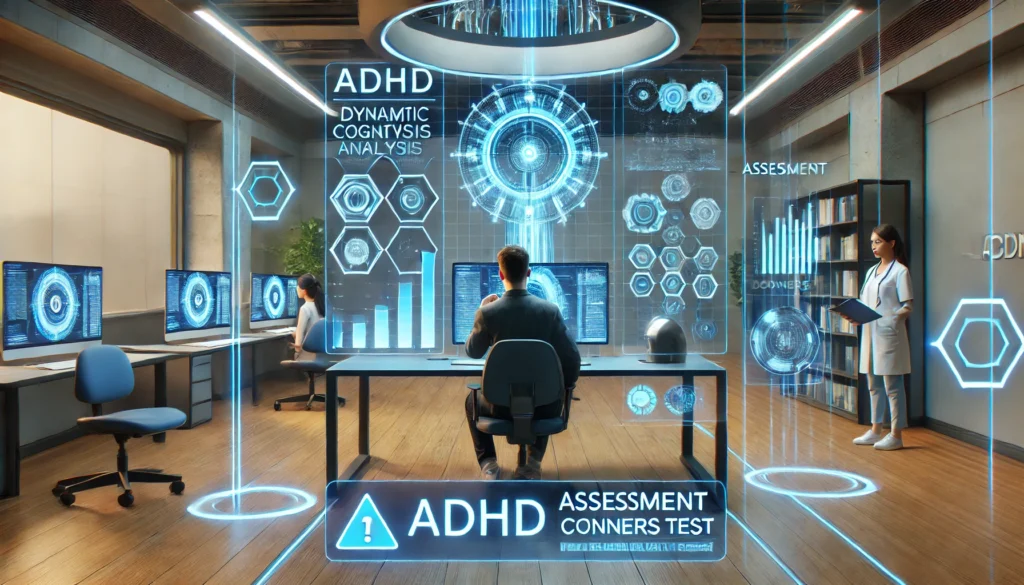In the ever-evolving landscape of mental health, understanding Adult Attention Deficit Hyperactivity Disorder (ADHD) has become increasingly crucial. The Conners Test, specifically designed for adults, is a key tool in diagnosing and managing this condition. This comprehensive guide aims to illuminate the nuances of the Conners Test, providing you with the knowledge to better understand its application and significance.
You may also like: Enhancing Concentration: Strategies for ADHD
Understanding Adult ADHD
Before delving into the specifics of the Conners Test, it is essential to comprehend what Adult ADHD entails. ADHD is a neurodevelopmental disorder that, while often associated with children, can persist into adulthood. Adults with ADHD may struggle with maintaining attention, controlling impulses, and may have issues with hyperactivity. These symptoms can significantly impact daily functioning and quality of life.
Symptoms and Challenges
Symptoms of Adult ADHD can vary but often include difficulty focusing, forgetfulness, impulsivity, and restlessness. These symptoms can manifest in different ways, such as frequent daydreaming, misplacing items, and making careless mistakes at work or in personal projects. This inattentiveness can lead to significant setbacks in both personal and professional arenas.
In a professional setting, these symptoms might result in missed deadlines, underperformance, or difficulty maintaining employment. Personal relationships can also suffer, as impulsivity and restlessness may lead to misunderstandings or conflicts with loved ones. Furthermore, the mental strain of managing these symptoms without support can exacerbate stress and anxiety, further impacting an individual’s overall well-being.
The Importance of Diagnosis
A proper diagnosis is vital for managing ADHD effectively. Without it, individuals may feel overwhelmed by their symptoms and unsure of how to proceed. Diagnosis opens the door to understanding the condition better and devising strategies to manage it.
When diagnosed, individuals can explore various treatment options, including therapy, medication, or a combination of both. This is where the Conners Test comes into play, offering a structured approach to diagnosing ADHD in adults. By identifying specific symptoms and their severity, the test aids in crafting a personalized treatment plan that addresses the unique challenges faced by each individual.
Long-Term Implications of Adult ADHD
Understanding the long-term implications of untreated ADHD is crucial. Without intervention, adults with ADHD might face persistent challenges that affect their career progression, financial stability, and personal relationships. The disorder can also increase the risk of developing additional mental health issues, such as depression and anxiety.
Early diagnosis and treatment can significantly alter this trajectory, enabling individuals to manage their symptoms effectively and lead fulfilling lives. With the right support, those with ADHD can harness their unique strengths and mitigate the challenges posed by the disorder.

What is the Conners Test?
The Conners Test, officially known as the Conners’ Adult ADHD Rating Scales (CAARS), is a comprehensive assessment tool designed to evaluate ADHD symptoms in adults. It provides valuable insights into the severity and specific nature of an individual’s symptoms, aiding healthcare professionals in making informed diagnostic decisions.
Components of the Conners Test
The Conners Test consists of several components, including self-report questionnaires and observer forms. Self-report questionnaires allow individuals to reflect on their own experiences and provide firsthand accounts of their symptoms. These forms are crucial in capturing the subjective experience of living with ADHD.
Observer forms, on the other hand, are completed by people who know the individual well, such as family members, friends, or colleagues. These external perspectives offer an additional layer of insight, capturing behaviors and symptoms that the individual might not fully recognize or report themselves. This dual approach ensures a comprehensive understanding of the individual’s ADHD symptoms.
The test evaluates various aspects of behavior and cognitive functioning, such as attention span, hyperactivity, and impulsivity. By examining these areas, the Conners Test offers a well-rounded view of the individual’s ADHD symptoms, helping clinicians identify patterns and areas of concern.
Scoring and Interpretation
The Conners Test uses a standardized scoring system to quantify the presence and severity of ADHD symptoms. Each symptom is rated, and the scores are compiled to create an overall picture of the individual’s experience with ADHD.
Scores are compared against normative data, which represents a sample of the general population without ADHD. This comparison allows clinicians to determine whether an individual’s symptoms align with ADHD diagnostic criteria. The standardized nature of the scoring ensures that assessments are consistent and reliable across different individuals and settings.
Interpreting the scores involves understanding the nuances of ADHD symptoms and how they impact daily life. Clinicians use these insights to guide discussions with the individual about their symptoms and potential treatment options, ensuring a personalized and effective approach to managing ADHD.
The Role of the Conners Test in Comprehensive Assessment
While the Conners Test is a valuable tool, it is often used in conjunction with other assessments and evaluations. A comprehensive ADHD assessment typically includes clinical interviews, medical history reviews, and possibly other psychological tests. This multi-faceted approach ensures that the diagnosis is accurate and considers all aspects of the individual’s mental health.
The Conners Test contributes significantly to this comprehensive assessment by providing structured and quantifiable data on ADHD symptoms. Its results complement other assessment methods, helping to create a complete picture of the individual’s condition and guiding the development of a tailored treatment plan.
Accessing the Conners Test
For those interested in exploring the Conners Test, several options are available. While the test itself is a professional tool administered by healthcare providers, understanding how to access and utilize it is crucial for those seeking a diagnosis.
Finding a Qualified Professional
The first step in accessing the Conners Test is finding a qualified mental health professional. Psychologists, psychiatrists, and other licensed clinicians are equipped to administer the test and interpret its results. These professionals have the expertise to guide individuals through the assessment process and discuss the implications of the results.
It is essential to seek a professional with experience in adult ADHD to ensure an accurate assessment. Such specialists are familiar with the nuances of the disorder and can provide insights into both common and less typical symptoms. They can also offer guidance on the most appropriate treatment options based on the assessment findings.
Understanding Test Availability
The Conners Test is not typically available for direct download by individuals. Instead, it is provided through healthcare providers who have the training to administer and score it. This ensures that the test is used correctly and that the results are interpreted accurately.
However, understanding its components and what to expect can empower individuals to have informed discussions with their healthcare providers. Knowing the test’s structure and purpose can help individuals prepare for the assessment and collaborate effectively with their clinician to achieve the best possible outcomes.
Preparing for the Assessment Process
Preparing for the Conners Test involves more than just scheduling an appointment. Individuals can benefit from reflecting on their experiences and symptoms, considering specific instances where ADHD might have impacted their lives. Gathering input from people who know them well can also provide valuable insights that can be shared during the assessment.
Approaching the assessment process with an open mind and a willingness to engage with the clinician is crucial. This collaboration can lead to a more comprehensive understanding of the individual’s symptoms and ensure that the assessment accurately captures their experiences.

Interpreting Conners Test Results
Once the Conners Test has been administered, interpreting the results is a crucial step in the diagnostic process. This involves understanding what the scores mean and how they inform treatment decisions.
Key Findings and Their Implications
The test results will highlight areas of concern, such as inattention or hyperactivity, and their severity. These findings guide clinicians in determining whether an ADHD diagnosis is appropriate and, if so, what treatment options may be most effective.
Understanding these key findings can also help individuals make sense of their experiences and behaviors. Recognizing patterns in symptoms can clarify why certain challenges arise and provide a foundation for developing coping strategies and interventions.
Collaborating with Healthcare Providers
Interpreting the Conners Test results is not a solitary endeavor. It involves collaboration between the individual, their healthcare provider, and, in some cases, their support network. This collaborative approach ensures that the individual receives comprehensive care tailored to their unique needs.
Healthcare providers play a critical role in explaining the results and discussing potential next steps. They can offer recommendations for treatment and lifestyle changes that align with the individual’s goals and circumstances. Involving family members or close friends in these discussions can also enhance the support system available to the individual.
Developing a Personalized Treatment Plan
The insights gained from the Conners Test are invaluable in developing a personalized treatment plan. This plan may include a combination of medication, therapy, and lifestyle adjustments designed to manage symptoms and improve quality of life.
Clinicians work closely with individuals to identify the most suitable treatment options based on their specific symptoms and preferences. This collaborative approach empowers individuals to take an active role in managing their ADHD and achieving their personal and professional goals.
Managing ADHD Post-Diagnosis
A diagnosis of ADHD is not an endpoint but a stepping stone to effective management. With the insights gained from the Conners Test, individuals can explore various treatment options and lifestyle adjustments to enhance their quality of life.
Treatment Options
Treatment for Adult ADHD often involves a combination of medication and behavioral therapy. Medications, such as stimulants and non-stimulants, can help manage symptoms, while therapy provides strategies for coping with challenges and improving daily functioning.
Therapy can include cognitive-behavioral techniques aimed at addressing negative thought patterns and developing problem-solving skills. Additionally, coaching and skills training can support individuals in building organizational and time-management abilities, which are often areas of difficulty for those with ADHD.
Lifestyle Changes and Support
In addition to medical treatment, lifestyle changes can play a significant role in managing ADHD. This may include implementing organizational strategies, maintaining a structured routine, and seeking support from ADHD-focused support groups or counseling.
Creating an environment that minimizes distractions and promotes focus can be beneficial. This might involve decluttering workspaces, using planners or digital tools to track tasks, and establishing consistent daily routines. Support groups offer a platform for sharing experiences and learning from others facing similar challenges, providing both practical advice and emotional support.
Building a Supportive Environment
Building a supportive environment is crucial for managing ADHD effectively. This involves open communication with family members, friends, and colleagues about the challenges of ADHD and the specific support needed.
Educating others about ADHD can help reduce stigma and foster understanding, leading to more supportive and accommodating interactions. Establishing clear expectations and boundaries can also aid in minimizing misunderstandings and enhancing relationships.

The Future of ADHD Assessment
The Conners Test remains a cornerstone in ADHD assessment, but the field is continually evolving. Advances in neuroscience and technology are paving the way for more precise diagnostic tools and personalized treatment approaches.
Emerging Trends and Technologies
New methodologies, such as digital assessments and neuroimaging, are being explored to complement traditional assessment tools like the Conners Test. Digital assessments can provide real-time data and insights into an individual’s behavior in naturalistic settings, offering a more comprehensive understanding of ADHD symptoms.
Neuroimaging techniques, such as functional MRI, are being investigated for their potential to identify structural and functional differences in the brains of individuals with ADHD. These innovations hold the promise of enhancing diagnostic accuracy and tailoring interventions to individual needs, offering a more personalized approach to ADHD management.
Implications for Individuals with ADHD
For individuals with ADHD, these advancements offer hope for more effective management and improved quality of life. Staying informed about emerging trends and technologies can empower individuals to advocate for their health and explore new avenues for treatment.
As the field of ADHD research continues to evolve, individuals can benefit from engaging with ongoing studies and discussions about innovative approaches. By staying informed and open to new possibilities, individuals can actively participate in their care and embrace opportunities for improved outcomes.
The Role of Research and Advocacy
Research and advocacy play a vital role in the future of ADHD assessment and treatment. Ongoing studies help to refine existing tools and develop new ones that address the diverse needs of those with ADHD.
Advocacy efforts aim to raise awareness about ADHD and promote policies that support individuals in accessing appropriate assessments and treatments. By participating in advocacy initiatives, individuals and communities can contribute to a broader understanding of ADHD and work towards a more inclusive and supportive society.
Conclusion
The Conners Test is a vital tool in understanding and managing Adult ADHD. By providing a structured assessment of symptoms, it lays the foundation for accurate diagnosis and effective treatment. For those navigating the complexities of ADHD, the Conners Test offers clarity and direction, guiding individuals toward a path of improved mental health and well-being.
In embracing the insights provided by the Conners Test, individuals can take proactive steps toward managing their ADHD and unlocking their full potential. Whether you are a health and wellness coach, a science journalist, or a biohacker, understanding the Conners Test is an essential part of the journey toward optimal mental health.
By staying informed and engaged with ongoing developments in ADHD assessment and treatment, individuals can be at the forefront of their own care, advocating for the resources and support needed to thrive. The Conners Test, alongside emerging tools and approaches, offers a beacon of hope and a pathway to a more fulfilling life for those with ADHD.
Further Reading:
Conners Scale for ADHD Assessment
Adult ADHD Tests, Self-Assessments, & Quizzes
CONNERS – ADHD Checklists and Rating Scale Summary Sheet – PDF
Important Note: The information contained in this article is for general informational purposes only, and should not be construed as health or medical advice, nor is it intended to diagnose, prevent, treat, or cure any disease or health condition. Before embarking on any diet, fitness regimen, or program of nutritional supplementation, it is advisable to consult your healthcare professional in order to determine its safety and probable efficacy in terms of your individual state of health.
Regarding Nutritional Supplements Or Other Non-Prescription Health Products: If any nutritional supplements or other non-prescription health products are mentioned in the foregoing article, any claims or statements made about them have not been evaluated by the U.S. Food and Drug Administration, and such nutritional supplements or other health products are not intended to diagnose, treat, cure, or prevent any disease.


